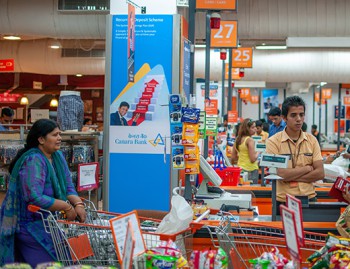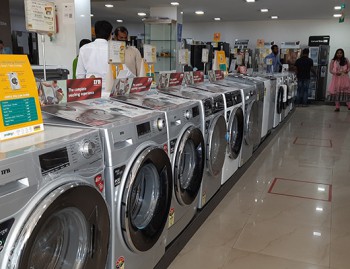INTRODUCTION
The Indian consumer durables market is broadly segregated into urban and rural markets and is attracting marketers from across the world. The sector comprises of a huge middle class, relatively large affluent class and a small economically disadvantaged class. Global corporations view India as one of the key markets from where future growth is likely to emerge. The growth in India’s consumer market would be primarily driven by a favorable population composition and increasing disposable income.

MARKET SIZE

- Appliances and consumer electronics industry stood at US$ 9.84 billion in 2021 is expected to more than double to reach Rs. 1.48 lakh crore (US$ 21.18 billion) by 2025.
- In May 2021, consumer durables output increased by 98.2%, compared with 70.3% decline in May 2020.
- Electronics hardware production in the country stood at US$ 63.39 billion in 2021.
- In FY20, TV penetration in India stood at 69%, driven by the DTH market.
- The total active subscriber base has increased from 69.57 million in March 2021 to 69.86 million in June 2021.
- As of 2021, the refrigerator, washing machines and air conditioner market in India were estimated around US$ 3.82 billion, US$ 8.43 billion and US$ 3.84 billion, respectively.
- According to India Cellular & Electronics Association (ICEA), India has the potential to achieve a value of US$ 100 billion in manufacturing of laptops and tablets by 2025.
- Smartphone shipments witnessed YoY growth of 11% in 2021 with 169 million units shipped.
- India’s smartphone market revenue crossed US$ 38 billion in 2021 with 27% YoY growth, with the leader being Xiaomi with 24% shipment share.
- The headset market revenue in India is projected to reach US$ 77 million by 2027 at a CAGR of 4.7%, driven by rising adoption of wireless headsets among consumers.
- The dishwasher market in India is expected to surpass US$ 90 million by 2025-26, driven by rising demand from metro cities such as Mumbai, Hyderabad, Delhi and Bangalore.
- The flat panel television (LED, LCD, HD, and UHD) market in India was valued at US 9.05 billion in FY18 and is expected to reach US$ 16.24 billion by FY24, growing at a CAGR of 9.25%.
- In 2021, TV shipments grew 24% YoY, with the smart TV market also registering 65% YoY growth.
- According to a report by Care Ratings, consumer electronics and appliances manufacturers are set to increase their production by 5-8% in FY22, after witnessing a contraction in demand in FY21.
- According to RedSeer, India's consumer digital economy is projected to reach US$ 800 billion by 2030, from US$ 85-90 billion in CY20, driven by increase in online shopping.
- In September 2021, the Quick Estimates of Index of Industrial Production (IIP), for consumer durables stood at 126.4 (under the use-based classification).
- Consumer durable loans in India stood at Rs. 25,100 crore (US$ 3.29 billion) in FY21, up from Rs. 24,000 crore (US$ 3.15 billion) in FY20.
- E-commerce companies reported sales worth US$ 9.2 billion across platforms in October and November 2021, driven by increased shopping during the festive season. With festive season sales, Flipkart Group emerged as the leader with a 62% market share.
INVESTMENTS
According to Department for Promotion of Industry and Internal Trade, between April 2020 and March 2021 (FY21), exports of electronic goods from India stood at US$ 11.1 billion.
Between April 2000-December 2021, electronic goods attracted FDI inflows of US$ 3.19 billion.
Following are some recent investments and developments in the Indian consumer market sector.
- In November 2021, PG Technoplast Pvt. Ltd. received government approval under the production-linked incentive (PLI) scheme for white goods in the air conditioner components category.
- In November 2021, Tata Consumer Products (TCPL) signed definitive agreements to acquire 100% equity shares of Tata SmartFoodz Limited (TSFL) from Tata Industries Limited, for a cash consideration of Rs. 395 crore (US$ 53.13 million). This move was in line with TCPL’s strategic intent to expand into value added categories
- In September 2021, Blue Star Climatech, the wholly owned subsidiary of Blue Star, announced its plans to invest Rs. 550 crore (US$ 73.45 million) over the next few years to set up a new manufacturing facility at Sri City, in Andhra Pradesh’s Chittoor district.
- In September 2021, US-based consumer electronics brand Westinghouse Electric Corporation, forayed into the Indian market by launching a range of TV sets. The brand collborated with its Indian licensing partner Super Plastronics Pvt Ltd (SPPL) and signed an exclusive licensing agreement with it.
- In September 2021, Airtel Digital TV, the DTH arm of Bharti Airtel, introduced Made-in-India high-definition set-top boxes for customers. The boxes are being manufactured in Noida, Uttar Pradesh, by Skyworth Electronics. Airtel plans to fully transition to Made-in-India set-top boxes, including the high-end Airtel Xstream 4K Android TV box, by the end of 2021 and contribute towards local manufacturing and the Government of India’s Atmanirbhar vision.
- In August 2021, Lenovo announced that it is considerably expanding its local manufacturing capabilities in India across product categories, such as PCs, laptops and smartphones, to satisfy rising consumer demand.
- In August 2021, Philips announced to invest Rs. 300 crore (US$ 40.41 million) and recruit 1,500 employees in India. The company announced plans to expand its Pune operations to increase manufacturing in India.
- In July 2021, Godrej & Boyce announced entry into the dishwasher market and aims to capture 15% market share by FY22. The company is focusing on key markets such as Mumbai, Hyderabad, Bengaluru and Delhi and plans to expand to tier II cities.
- G.O.A.T Brand Labs raised funds worth US$ 36 million from Flipkart Ventures and Tiger Global in August 2021. The company aims to collaborate and invest in digital brands and offer plug-and-play platform to accelerate growth. In line with this, the company is focusing on brands across areas such as home & kitchen, beauty and personal care.
- Indian markets such as Hyderabad is expected to become a manufacturing smart TV. The market is also witnessing rising focus of players (for example, Radiant Appliances and Electronics (REA)) to manufacture LED TVs for global markets.
- TCL Group announced, in June 2021, to start manufacturing handsets and TV display panels (from the fourth quarter) in Andhra Pradesh. The company plans to recruit 1,000 employees. This development was in line with the company’s plan to invest ~US$ 219 million to manufacture display modules in the country.
- In April 2021, Godrej Appliances announced an investment of Rs. 100 crore (US$ 13.6 million) across two of its manufacturing facilities—Shirwal in Maharashtra and Mohali in Punjab—to expand its production capacity for air-conditioners (to 800,000 units) by 2025.
- In April 2021, Zetwerk Manufacturing, a B2B online marketplace, announced that it is entering the apparel and consumer durable sectors amid increased demand and supply chain disruptions after the outbreak of COVID-19.
- Super Plastronics, a brand licensee for Kodak HD LED TVs for India, announced in March 2021 that it will invest Rs. 300 crore (US$ 40.26 million) to strengthen its capabilities in IoT technologies and tap emerging opportunities in the smart home devices market.
- In January 2021, Panasonic India announced its plan to double its residential air-conditioning business by 2024.
- In January 2021, the Indian smartphone firm, Lava Mobiles released the world's first customisable smartphone that enables users to select components, such as camera, memory, storage space and colour, from the company's website on their own.
GOVERNMENT INITIATIVES
- In November 2021, Flipkart signed an MoU with the Ministry of Rural Development of the Government of India (MoRD), for their ambitious Deendayal Antyodaya Yojana – National Rural Livelihood Mission (DAY-NRLM) programme, to empower local businesses and self-help groups (SHGs) by bringing them into the e-commerce fold.
- In September 2021, FICCI Electronics Manufacturing Committee Chairperson Mr. Manish Sharma said that ~52 companies have applied for availing PLIs for white goods makers, proposing an investment of ~Rs. 6,000 crore (US$ 813 million) in manufacturing components for air conditioners (ACs) and LED lights. Most of these investments are expected to happen in the next 2-3 years; following this, local production for components for ACs and LED lights is expected to start.
- In July 2021, the government approved 14 companies under the production linked incentive (PLI) scheme for IT hardware. Over the next four years, these companies are expected to fuel total production of >US$ 21.64 billion.
- In June 2021, the government extended the production-linked incentive (PLI) scheme for large scale electronics manufacturing by a year (until FY26), giving a boost to the industry.
- The Indian government has been encouraging to consumer durable brands in India to ‘Make in India’ thereby expecting they should be self-reliant for the future; consumer too are showing an affinity towards homegrown products.
- The National Policy on Electronics 2019 is targeting production of one billion mobile handsets valued at US$ 190 billion by 2025, out of which 600 million handsets valued at US$ 100 billion are likely to be exported.
- The Government of India has allowed 100% Foreign Direct Investment (FDI) under the automatic route in Electronics Systems Design and Manufacturing sector. FDI into single brand retail has been increased from 51% to 100%; the government is planning to hike FDI limit in multi-brand retail to 51%.
- In September 2020, the Government of India planned to offer production-linked incentives worth Rs. 1.68 trillion (US$ 23 billion) to companies such as consumer appliance, automobile and solar panel to attract companies to establish manufacturing plants in India.
- On November 11, 2020, Union Cabinet approved the Production-Linked Incentive (PLI) scheme in 10 key sectors (including electronics and white goods) to boost India’s manufacturing capabilities, exports and promote the ‘Atmanirbhar Bharat’ initiative.
- The PLI scheme, which has been approved for 16 electronics firms, including 10 manufacturers of mobile handsets, would further improve India's role in the global mobile market and complement the goal of making the country a global mobile production hub for manufacturers.
ROAD AHEAD
Indian appliance and consumer electronics (ACE) market is expected to increase at 9% CAGR to reach Rs. 3.15 trillion (US$ 48.37 billion) in 2022. Demand growth is likely to accelerate with rising disposable income and easy access to credit. Increasing electrification of rural areas and wide usability of online sales would also aid growth in demand. The government anticipates that the Indian electronics manufacturing sector will reach US$ 300 billion (Rs. 22.5 lakh crore) by 2024–25.

References: Media reports, press releases, Press Information Bureau (PIB), Boston Consulting Group, International Data Corporation.
Consumer Market Clusters

Industry Contacts
- Consumer Guidance Society of India
- Retailers Association of India
- Consumers Association of India
- Consumer Electronics and Appliances Manufacturers Association
- Electronic Industries Association of India (ELCINA )